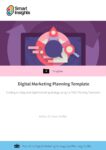Our latest summary of ad clickthrough rates statistics in the US, Europe, and Worldwide is designed to help you benchmark your paid digital and social media ads, set marketing budgets, and define your goals
If you're forecasting your digital media spend, you need to compare the ROI of your display ads, paid social, Google Ads, and social media. Depending on your objectives, it's worth reviewing and benchmarking the latest metrics like average click-through rates, average cost per click, and cost per lead.
I've put this compilation together to help marketing professionals create direct response conversion models for digital marketing campaigns. By creating budget models using known benchmarks for average CTRs and digital media click-through costs, you can better forecast your return on investment from digital media ads. Our budgeting and forecasting spreadsheets include:
This data is particularly useful if you haven't previously invested in advertising on publisher sites through ad networks or paid social media ads since it can help make the case and set expectations with colleagues or clients of the number of visits based on quantitative forecasts. As always, we recommend applying a targeted, data-driven approach to your marketing activities and we have tools and templates to help.
If you're looking to identify and prioritize digital marketing channels for growth, don't miss our step-by-step integrated RACE digital marketing plan template. Our most popular free download helps managers, marketers, and small business owners streamline their planning and improve performance. Find out more about the RACE Framework and the integrated marketing strategy tools covered in this blog when you join Smart Insights as a Free Member.
Free digital marketing plan template
Our popular marketing planning template is structured across the Smart Insights RACE Framework. Join Smart Insights as a Free Member to download our digital marketing plan template today
Access the Free digital marketing plan template
Average CTR benchmarks - February 2024 update
We’ve updated our compilation of average clickthrough rates, cost per click, and cost per lead across Google Ads, Facebook, Instagram, Twitter and LinkedIn.
Each year, we update our statistics summaries with the latest research as it becomes available. Stats are in three sections which answer these questions:
- Q. What are average display ad CTRs for different industries?
- Q. What average CPC/ cost per lead can industry marketers expect?
- Q. What are social media ad clickthrough rates - a comparison of Facebook, Instagram, LinkedIn and Twitter CTRs?
Search Marketing Benchmarks: Average click-through rate
One of the best sources for PPC data is LocalIQ/Wordstream paid search bencmarks. Note that the sample is typically for smaller local businesses. The data below details CTR, CPC, CR and CPL in 2023 for a wide range of business categories:
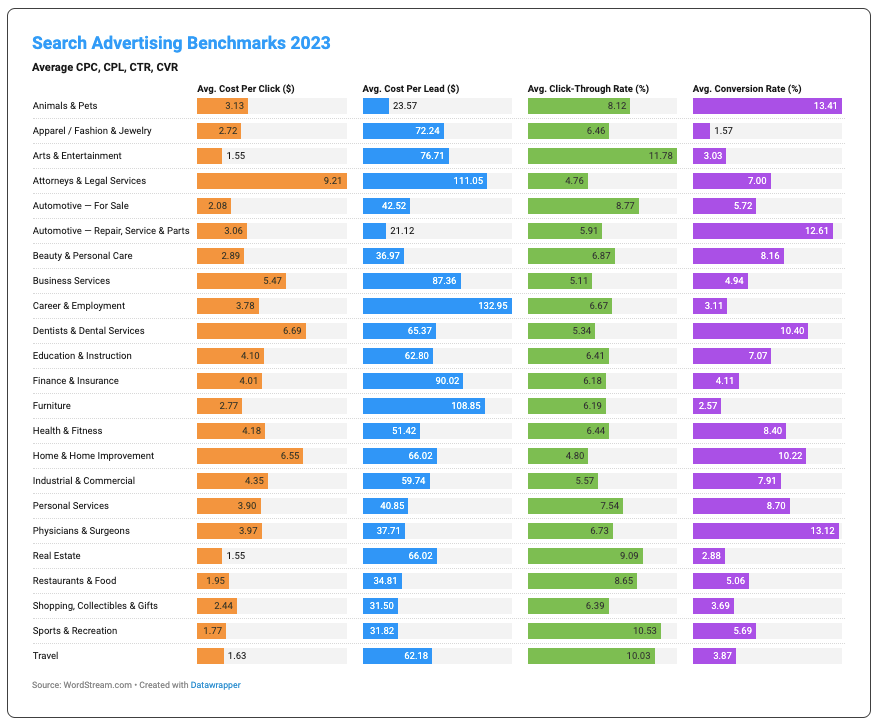
Of course, these figures are averages for each sector CTRs tend to be higher for brand searches and lower for generic searches.
Note on data source:
This chart is based on a sample of 4,595 North American-based LOCALiQ client accounts in the home services vertical who were running search advertising, display advertising, and/or social media advertising in 2023. Each subcategory includes a minimum 10 unique active clients. “Averages” are technically median figures to account for outliers.
CPC cost per click/ cost per lead search advertising benchmarks
Cost per click in search advertising is driven by many factors. As demonstrated in the table below, depending on the industry, a click could cost a marketer less than $2 or as much as $8-9, such as those in attorneys & legal services.
However, it's important to look at the bigger picture when defining the value of your clicks. $9 is still a very reasonable cost considering the high-value potential for each customer lifecycle in this industry. Therefore it's reasonable to presume that the CPC is driven up by high competition for a relatively smaller number of target customers (/clicks).
We also have a comparison of Google organic Clickthrough rates by position.
Alternative data on CTRs for larger businesses
For brand engagement rates, one of the best sources for insight on paid media engagement including CTR and cost is the Skai research. Skai (formerly Kenshoo) is a performance marketing platform offering advertising Placements on Google, Meta, Amazon Ads, TikTok, Snap, Walmart Connect, Instacart, Roundel, Criteo, CitrusAd, Pinterest, Microsoft, Apple Search Ads, and more.
Brands using it include Pepsico, Diageo, Reckitt, Daimler, LG, and Vodafone. It is one of the few sources available offering CTR benchmarks for search and display. Trends in retail categories are also shown in the full report. The most recent version published as of Jan 2024 includes Q3 of 2023, these are shared below.
Paid search (Google Ads) CTR and CPC trends
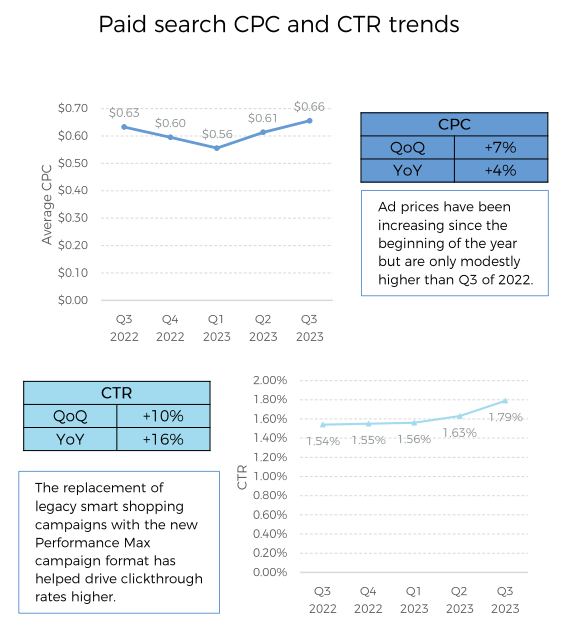
Retail media CTR and CPC trends
Retail media include retailers such as Amazon and Walmart and ad networks such as Criteo.
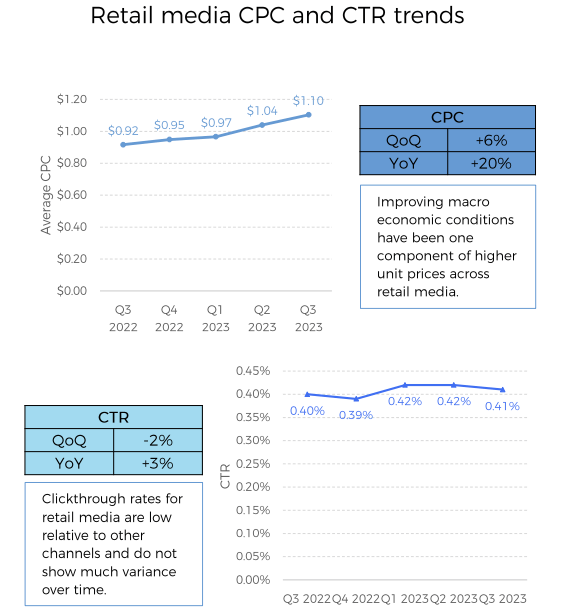
Paid social CTR
Unfortunately, there isn't a breakdown by social network in the Skai data, but the majority of the spend is with Meta platforms Facebook and Instagram. This shows how CTR is typically around 1.1-1.3% in social feeds which is significantly higher than the lower historic data reported for display towards the end of this article.
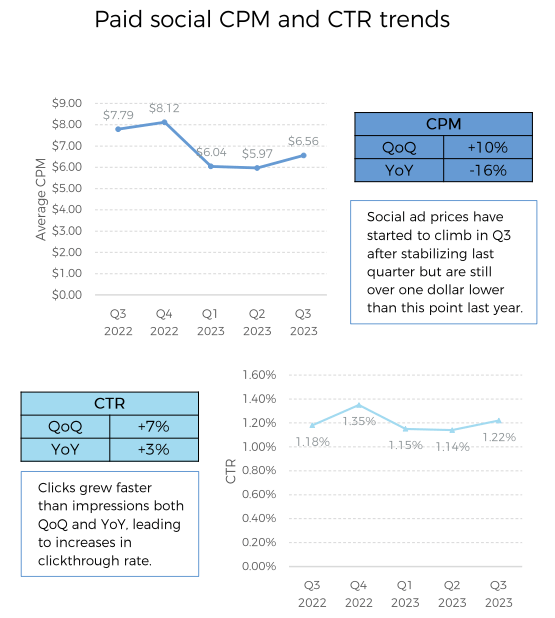
Further insight on organic and paid social engagement across Facebook, Instagram, Twitter and TikTok is available from the Emplify (formerly Social Bakers) social media industry reports which cover 6 industries.
Google Ads (formerly AdWords) display network benchmarks
LocalIQs Google Adwords industry benchmarks average CTRs now report just on the Google Ads search network accounts they manage. They no longer report on the display network. This typically has sub one-percent CTRs.
Google Doubleclick benchmarks for ad placement
Unfortunately, Google has removed CTRs reported for its Doubleclick display brand and their interactive Display benchmarking tool. So now we can only present previous data. No other alternatives are available as far as I'm aware.
Previous pre-2015 Doubleclick data shows an average CTR of just 0.05% for all display formats, i.e just 5 clicks per 10000 impressions, showing the difficulty of driving direct response from online display or banner ads. Perhaps that is why Google no longer publishes this data...
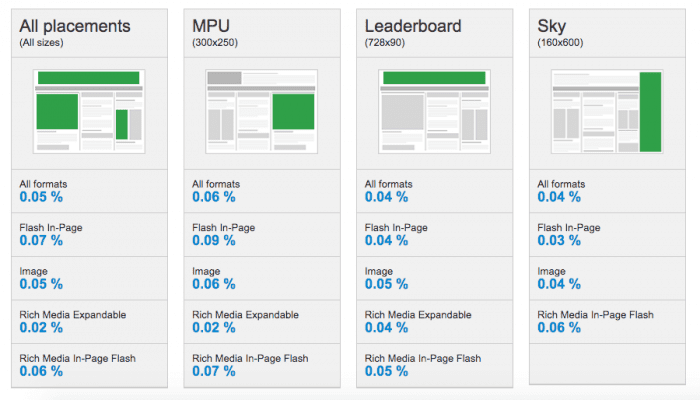
While this is a really low CTR, however you look at it, cross-media optimization tests shows that online ads do help increase brand awareness and purchase intent, particularly when combined with offline media.
It's not the case that the majority of ad viewers have 'banner blindness' and are not aware of ads that are viewable placements. If this were the case, businesses wouldn't invest in the level of display and programmatic ads that they do.
We also see much higher CTRs online for other online ad formats like Google AdWords and Facebook - these can exceed 1%, so are more effective in driving volume and also typically have higher intent, so conversion rates are higher.
Tests from the likes of Dynamic Logic and Millward Brown conclusively show that display ads also encourage site visits (view throughs) and searches even where people don't click on ads.
Variation in online average CTRs for display ads by country
This is historic Doubleclick data for reference.
| Region |
Overall Click-through Rate Percent (%) |
| North America |
| Canada |
0.09% |
| United States |
0.10% |
| EMEA |
| Austria |
0.11% |
| Belgium |
0.13% |
| Denmark |
0.12% |
| Finland |
0.05% |
| France |
0.12% |
| Germany |
0.11% |
| Greece |
0.17% |
| Ireland |
0.10% |
| Italy |
0.10% |
| Luxembourg |
0.09% |
| Netherlands |
0.14% |
| Norway |
0.11% |
| Spain |
0.12% |
| Sweden |
0.08% |
| Switzerland |
0.12% |
| United Arab Emirates |
0.18% |
| United Kingdom |
0.07% |
| JAPAC |
| Australia |
0.07% |
| China |
0.12% |
| Hong Kong |
0.17% |
| India |
0.18% |
| Malaysia |
0.30% |
| Singapore |
0.19%
|
Source: DoubleClick for Advertisers, a cross section of regions, January and December 2009, Published July 2010
Variation in online average CTRs by ad format
Ad clickthrough rate naturally varies according to placement (position on screen) and ad format (shape and size). The traditional full-banner performs very poorly compared to skyscrapers, the ubiquitous medium rectangle and the newer large rectangle format.
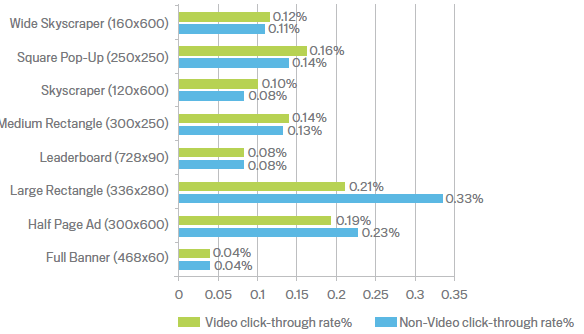
Variation in online ad Interaction Rates by ad format
Interaction rates differ for different ad formats in a similar way to ad formats.
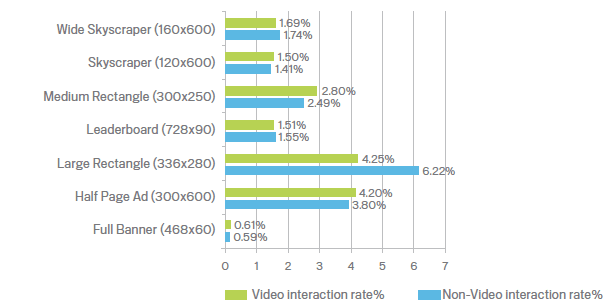
Interaction rate definition:
Interactions are defined as the user does one or more of the following:
- Mouses over the ad for 1 continuous second
- Clicks an Exit link
- Makes the ad display in Full Screen mode
- Expands the ad
Google responsive display ads
Note that more recently Google introduced Responsive Display ads on the Google Display Network as the default ad type. These involve uploading your assets (images, headlines, logos, videos and descriptions) and Google will automatically generate ads to be shown on the Google Display Network.
Reports from early adopters suggest that these can have relatively high CTRs. This example of CTRs compared a Google Ads campaign provided by Smart Insights Expert commentator David Miles. It shows the uplift he received when testing this new format.

Still deciding where to invest your resources? Structure your marketing plan around a funnel proven to boost performance. Join Smart Insights as a Free Member for instant access to our free digital marketing plan template to hone your skills and drive the results you need.
Free digital marketing plan template
Our popular marketing planning template is structured across the Smart Insights RACE Framework. Join Smart Insights as a Free Member to download our digital marketing plan template today
Access the Free digital marketing plan template
What are social media average CTRs - a comparison of Facebook and Twitter?
Again, we will use the Q1 2020 ad benchmark report from AdStage as our primary data source. Here are the media CTRs for their clients in North America:
Facebook ad CTR
The average Facebook CTR in the newsfeed is 1.11%. This is trending downwards; a decrease of 0.37% compared to the previous year.
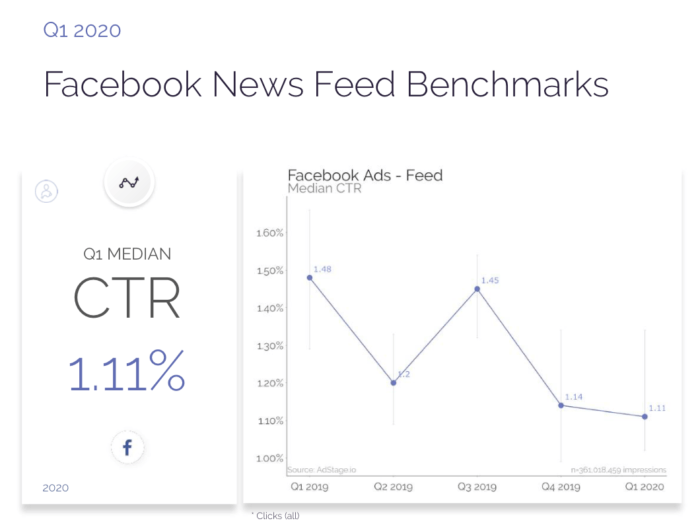
Other data reported includes:
- CTR on the right side placement averages just 0.16%.
- Facebook Stories have an average CTR of 0.79%.
- Facebook Audience network is 0.69% (mainly used for promoting apps such as gaming apps on publisher sites and in apps). This uses a range of ad formats such as display, native and video.
Instagram ad CTR
Instagram ad clickthrough rate in the feed is 0.22%, significantly lower than in the previous year and much lower compared to Facebook. This reflects the visual nature of Insta which doesn't offer opportunities for CTR in organic newsfeeds (other than Stories). Benchmarks for Stories are a little higher at 0.33%.
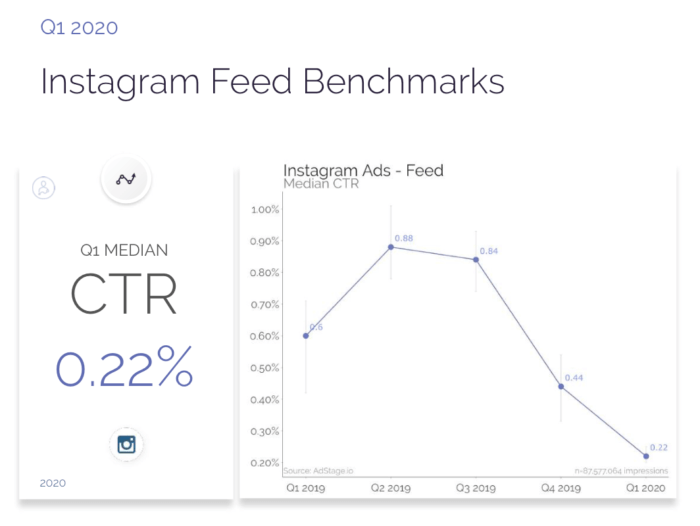
LinkedIn Ad CTR
Although the audience is quite different since LinkedIn targets B2B audiences, there is a similar CTR in LinkedIn of 0.22%.
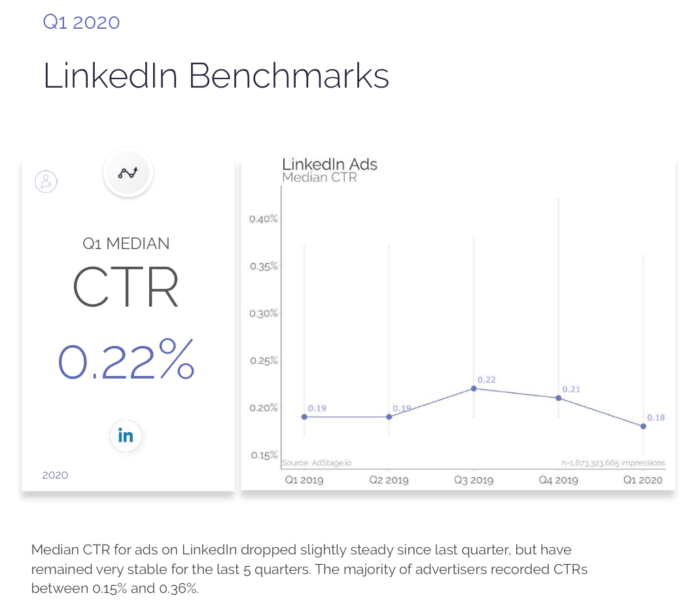
Twitter Ad CTR
Twitter has a higher clickthrough rate, although there is a significant decrease in the last quarter. Fewer impressions are served to Adstage customers in this category so this insight should be treated with caution.
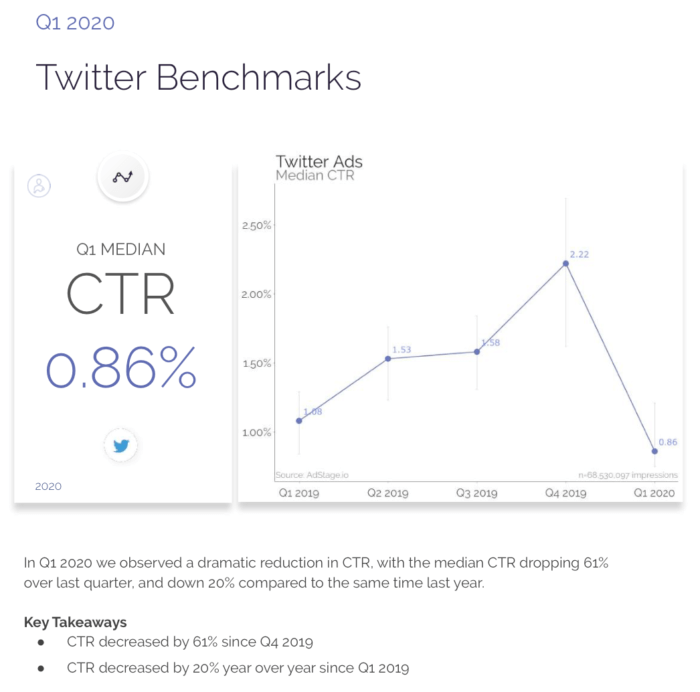
Historical data for context - comparison of display, search (AdWords) and social ads average CTRs
Since the Google-Doubleclick data is no longer available we're unable to update this data, but we have kept it in this post since it may be useful for readers to understand historic trends in CTR.
This comparison of average online media clickthrough rates from Marin is useful for modelling the response of digital media for top-level budgets.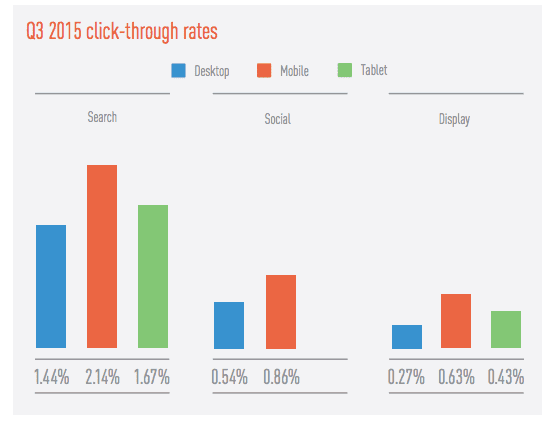
Facebook ad clickthrough rates by sector
Facebook offers different forms of ad formats with different goals will naturally vary in response as these retail Facebook ads from. You can see that Facebook ad CTRs which may be more highly targeted that display ads have significantly higher CTRs, particularly for Lead generation (i.e. adding subscribers to a retailers email list) and Dynamic Product ads (retargeting visitors who have already visited a site with relevant offers). 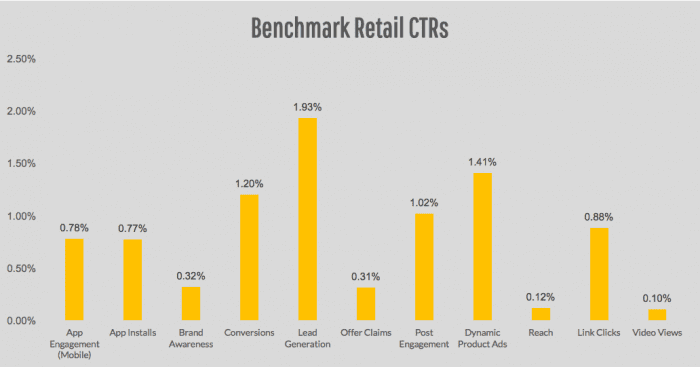
Wordstream also have these summary Facebook ad CTRs by sector:
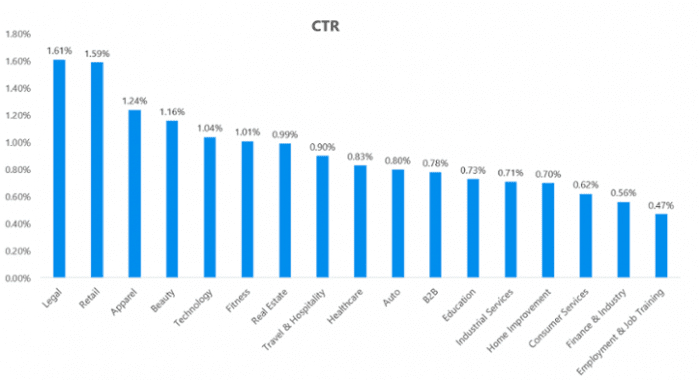
The challenge of online ad viewabililty
Viewability is another issue for advertisers to consider when evaluating online ad effectiveness as measured by clickthrough rates. Ad blocking also has an impact since ad blockers have increased in popularity across countries and demographics, accounting for 35% of ads in some countries.
Viewability refers to the percentage of ads in a campaign or on a publisher site that are potentially available for clickthrough. Just 44.9% of all ads are clickable according to Google-published viewability data since ads may be below the fold and users do not scroll to see them. This varies across publisher and content category.
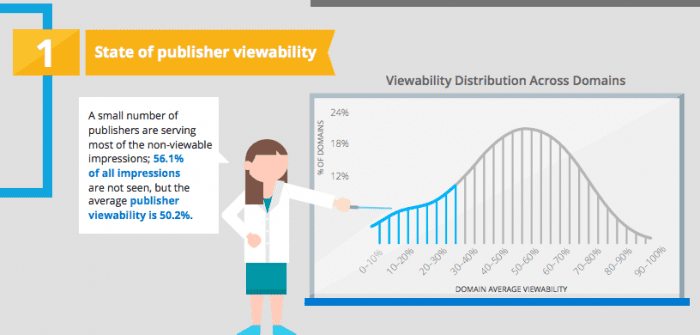
Given the impact of viewability and ad blocking on online ad clickthrough rates you can see that there are moves in the industry to only charge for viewable ads, which with increasing options for native advertising will potentially improve the effectiveness of ads.



